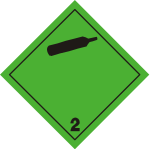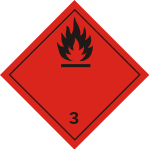Physical hazards pictograms
| Pictogram | Usage | |
|---|---|---|
 |
| |
| GHS01: Explosive | ||
 |
| |
| GHS02: Flammable | ||
 |
| |
| GHS03: Oxidizing | ||
 | ||
| GHS04: Compressed Gas | ||
 |
| |
| GHS05: Corrosive | ||
| ||
| no pictogram required | ||
Hazard pictograms form part of the international Globally Harmonized System of Classification and Labelling of Chemicals (GHS). Two sets of pictograms are included within the GHS: one for the labelling of containers and for workplace hazard warnings, and a second for use during the transport of dangerous goods. Either one or the other is chosen, depending on the target audience, but the two are not used together for the same hazard. [1] The two sets of pictograms use the same symbols for the same hazards, although certain symbols are not required for transport pictograms. Transport pictograms come in a wider variety of colors and may contain additional information such as a subcategory number.
Hazard pictograms are one of the key elements for the labelling of containers under the GHS, along with: [2]
The GHS chemical hazard pictograms are intended to provide the basis for or to replace national systems of hazard pictograms. It has still to be implemented by the European Union (CLP regulation) in 2009.
The GHS transport pictograms are the same as those recommended in the UN Recommendations on the Transport of Dangerous Goods, widely implemented in national regulations such as the U.S. Federal Hazardous Materials Transportation Act (49 U.S.C. 5101–5128) and D.O.T. regulations at 49 C.F.R. 100–185.
| Pictogram | Usage | |
|---|---|---|
 |
| |
| GHS01: Explosive | ||
 |
| |
| GHS02: Flammable | ||
 |
| |
| GHS03: Oxidizing | ||
 | ||
| GHS04: Compressed Gas | ||
 |
| |
| GHS05: Corrosive | ||
| ||
| no pictogram required | ||
| Pictogram | Usage | |
|---|---|---|
 |
| |
| GHS06: Toxic | ||
 |
Not used [3]
| |
| GHS07: Health Hazard/Hazardous to Ozone Layer | ||
 |
| |
| GHS08: Serious Health hazard | ||
| ||
| no pictogram required | ||
| Pictogram | Usage | |
|---|---|---|
 |
| |
| GHS05: Corrosive | ||
| Pictogram | Usage | |
|---|---|---|
 | Flammable gases – Gases which at 20 °C and a standard pressure of 101.3 kPa:
| |
| Division 2.1 | ||
 | Non-flammable non-toxic gases – Gases which:
| |
| Division 2.2 | ||
 | Toxic gases – Gases which:
e.g. hydrogen cyanide | |
| Division 2.3 | ||
| Pictogram | Usage | |
|---|---|---|
 | Flammable liquids – Liquids which have a flash point of less than 60 °C and which are capable of sustaining combustion e.g. acetone | |
| Class 3 | ||
 | ||
Flammable solids, self-reactive substances and solid desensitized explosives – Solids which, under conditions encountered in transport, are readily combustible or may cause or contribute to fire through friction; self-reactive substances which are liable to undergo a strongly exothermic reaction; solid desensitized explosives which may explode if not diluted sufficiently | ||
| Division 4.1 | ||
 | Substances liable to spontaneous combustion – Substances which are liable to spontaneous heating under normal conditions encountered in transport, or to heating up in contact with air, and being then liable to catch fire e.g. manganese heptoxide | |
| Division 4.2 | ||
 | Substances which in contact with water emit flammable gases – Substances which, by interaction with water, are liable to become spontaneously flammable or to give off flammable gases in dangerous quantities e.g. calcium carbide, sodium | |
| Division 4.3 | ||
| Pictogram | Usage | |
|---|---|---|
 | Oxidizing substances – Substances which, while in themselves not necessarily combustible, may, generally by yielding oxygen, cause, or contribute to, the combustion of other material | |
| Division 5.1 | ||
 | Organic peroxides – Organic substances which contain the bivalent –O–O– structure and may be considered derivatives of hydrogen peroxide, where one or both of the hydrogen atoms have been replaced by organic radicals | |
| Division 5.2 | ||
 | Toxic substances – Substances with an LD50 value ≤ 300 mg/kg (oral) or ≤ 1000 mg/kg (dermal) or an LC50 value ≤ 4000 ml/m3 (inhalation of dusts or mists) e.g. nearly everything that contains cyanide groups | |
| Division 6.1 | ||
 | Corrosive substances – Substances which:
| |
| Class 8 | ||
The following pictograms are included in the UN Model Regulations[ which? ] but have not been incorporated into the GHS because of the nature of the hazards.
 |  |  |  |  |  |
| Class 6.2 | Class 7 | Class 9 | |||
|---|---|---|---|---|---|
| Infectious substances | Radioactive material | Miscellaneous dangerous substances and articles | |||